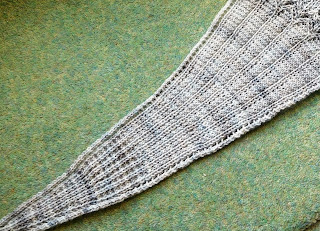You may remember this piece of needlepoint, started a little while back. It is intended as a panel for a little bag for daily use.
I began with a small hoard of crewel yarn, and thought myself very clever swapping in strands to create this ombre effect as the design reaches its centre. Of course I took no notes, but left some of each shade for use as I worked the second half.
Then, seven rows from the finish line, I ran out of a couple of key colours. This was vintage yarn, bought in Oxfam, obviously the leftovers from someone else's project. And it was very fine for crewel yarn. A little internet searching brought me to an online supplier of the same yarn, so I am hopeful that I will be able to finish. However, ordering some pale skeins for the background, along with the deep rusts need for the design itself has run up quite a little bill. not such a cheap project after all.
This is one of a pair of fingerless mitts knitted recently, and made up as I went along. In fact, the Newfoundland mitts gave me the basic stitch count - 42, increasing to 48 after the rib. So then all I had to do was place the cables, taking care to reverse them for the other hand, and do the increases for the thumb gusset at an appropriate rate. I used the cable pattern from the stalled oatmeal cardigan, so I didn't even need a stitch directory. The only modification I made on the second mitt was to decrease the cable stitches before casting off to tighten the finger edge.
However, on this version, I chose to place an elaborate motif on the back of the mitten. I could have planned it on graph paper but that is never my style. Instead, I saw how it went, and it almost worked. On the second mitt I am placing the motif more centrally, but starting it earlier, before the thumb gusset, so that it will finish neatly before the cast-off edge. Then I will probably ravel out mitt 1 and work it to match. I m only able to visualise things while actually working them through.
This is Colchester Castle where there is an astounding collection of Roman artefacts, including complete glass vessels from that period. We fitted in a visit while completing our Christmas shopping. Most interesting was the jewellery known as the Fenwick hoard, brought to light in 2014 when a department store was excavating for an extension. The items include long-service military arm bands as well as rings and ear-rings in the latest fashion. It was all thought to have been buried by a couple just prior to Boudicca's visitation. I have just read Rosemary Sutcliffe's "Song for a Dark Queen", a horrifying read. These items certainly give personality to that ancient massacre.































.JPG)